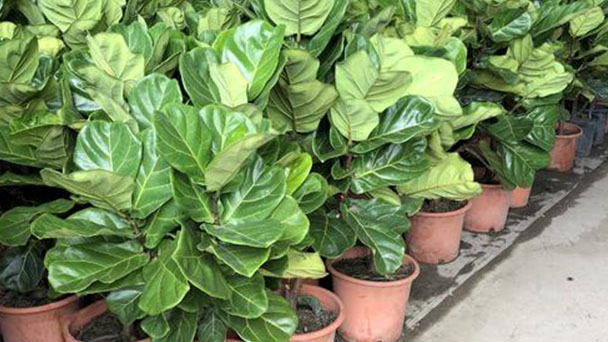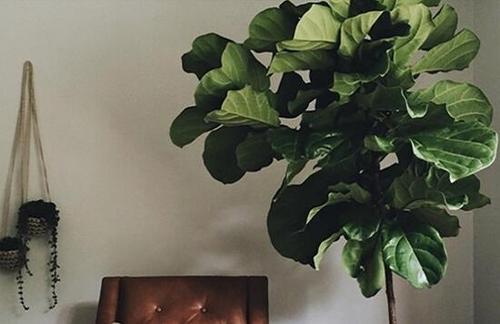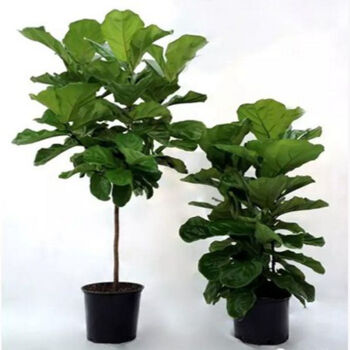How to care for Fiddle-leaf fig
Written by Maggie
Oct 09 2021

Fiddle-leaf fig has broad large leaves and graceful plant type, giving people a feeling of vigorous and upward. Now it has become a popular potted plant. But when growing it, a lot of flower friends find it often appears leaf hair is yellow or withered. How does this happen? How to care for Banban-leaf fig? Let's analyze it together!

Fiddle-leaf fig is one of the best trees for pots
How to care for Fiddle-leaf fig yellowing and withered
I. Soil for Fiddle-leaf fig
When we water plants, most of the water we use is tap water, and tap water is also known as hard water. If we water plants with hard water for a long time, a lot of salt will accumulate in the soil, which will lead to the yellow leaves of the plants withering.
Solution: You can use pure water in your daily watering. If there is no condition, you can put the tap water a few days in advance, or let the sun for a few days, and then water, so as to avoid the problem of soil alkalization.
2. Fertilization for Fiddle-leaf fig
Inadequate nutrient balance and little or no nitrogen use during fertilization can cause yellow leaves to wither. But some flower friends also can one-time apply big fertilizer, cause plants to burn root very easily, so the leaf can appear yellow.
Solution: You can add nitrogen fertilizer, but don't overapply it at one time. Use light fertilizer more often so the fertilizer doesn't hurt the roots.
3. Illumination for Fiddle-leaf fig
Fiddle-leaf fig has a strong adaptability to light and can grow well under bright scattered light. If exposed to the sun in summer, the leaves of Fiddle-leaf fig will turn yellow and wither. If kept in low light for a long time, it will cause the plants to grow feebly.
Solution: Avoid direct sunlight in summer, if placed outside must shade, winter should increase the amount of light. Fiddle-leaf fig is suitable for semi-shade environment growth. In summer to avoid direct sunlight, so as not to burn the leaves, so that the leaves lose luster. But the light is too weak, the plant grows thin and weak, so must give its brighter light, in order to grow healthily.
4. Pests and diseases control
Pests and diseases can also make the yellow leaves wither. So be careful in your daily maintenance. And it's best to clean the soil regularly.
Solution: After the plant comes on diseases, it is necessary to move to the place with sufficient sunlight and good ventilation in a timely manner, do not sprinkle water to the leaf surface, and the leaf that should come on is cut off. When cutting the diseased leaves, cut the spotted part and some healthy tissue together, and spray some disinfectant for protection.
5. Environment for Fiddle-leaf fig
In a new environment, the leaves of a plant are easily yellow. In fact, when changing pots for Banban-leaf fig, plants themselves can cause a variety of problems.
Solution: just follow the normal curing method to maintain it, and pay attention not to let the sun directly into it. If it is not for any major reason, it is not recommended that flower lovers change pots for plants.

Fiddle Leaf Fig - one of the best indoor trees
How to care for Fiddle-leaf fig leaves blackening
If the leaves of Fiddle-leaf fig appear black, it may be caused by water shortage. At this point there should be timely replenishment of water. In the summer aquaculture if the water is too low, the leaves of the plant because of the lack of water and gradually black. Increasing the air humidity and increasing astigmatism can improve the phenomenon of blackening leaves. The following are details of how to care for Fiddle-leaf fig leaves blackening.
1. Water properly
In the process of cultivation, it is found that what should be done about the blackening of the leaves of Fiddle-leaf fig. The requirements for water are not very high. If the blackening of the leaves of the plants is caused by too little watering, the amount of watering should be strictly controlled.
2. Raise the temperature
The blackening phenomenon of leaves in winter cultivation of Fiddle-leaf fig, which is caused by too low temperature. The temperature can be increased to 15℃ ~ 25℃, and the blackening phenomenon of plant leaves can be effectively improved by curing in a temperate environment, while the temperature should be reduced in summer cultivation.
3. Astigmatism
Fiddle-leaf fig is a light - liking plant. If there is no light for a long time, the leaves of the plant will gradually turn black, which is caused by the hindration of chlorophyll formation. More than 8 hours of light is needed in daily life, especially in winter growing, and low light time will affect the growth of the plant.
4. Raise the humidity
Another reason for the blackening of leaves is that the air is too dry. At this time, it is necessary to improve the blackening of leaves by spraying water to improve the air humidity. In summer breeding, excessive temperature makes the water evaporate more quickly and leaves lack water, so the blackening phenomenon will occur.

Latest Updated
- Benefits of Bugleweed - 7 Science-backed Health Benefits
- Bugleweed Dangers & Side Effects - Is It Poisonous?
- How to Plant Evergreen Trees - What You Should Know
- When to Plant Evergreens - Grow Guide for Evergreen Trees
- 12 Wonderful Evergreen Shrubs for Your Garden
- 12 Popular Evergreen Plants with Pictures for Beginners
- When And How To Prune A Lilac Bush Like a Pro
- How to Grow & Care for Lilac Vine (Hardenbergia Violacea)
- Japanese Lilac Tree (Syringa Reticulata) Care & Propagation Guide
- Shumard Oak Pros and Cons - What to Know
Popular Articles
- Winter maintenance of Antirrhinum Majus
- How to Grow Terminalia Mantaly Tree
- How to Grow and Care for Crossostephium Chinense
- How to grow Antirrhinum Majus in spring
- Peristeria Elata (Dove Orchid) Profile: Info & Care Guide
- Underwatered Snake Plant (Sansevieria Trifasciata) - Signs And How To Fix
- How to Care for Brazilian Jasmine Plant (Mandevilla Sanderi)
- How to Grow & Care for Graptopetalum Purple Delight in Summer
- Rosa Chinensis (China Rose): Plant Growing & Care Tips
- How to Care for Baby Sun Rose (Aptenia Cordifolia)